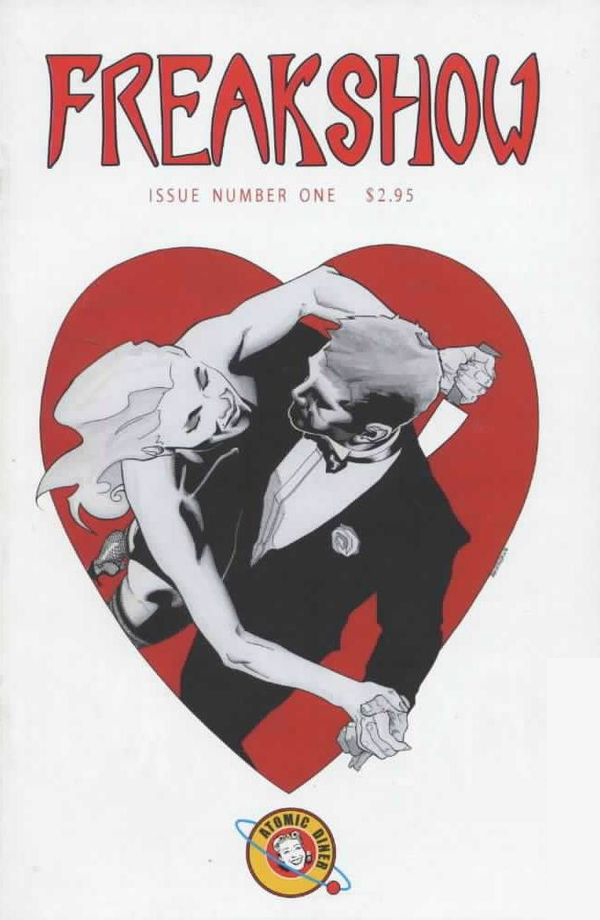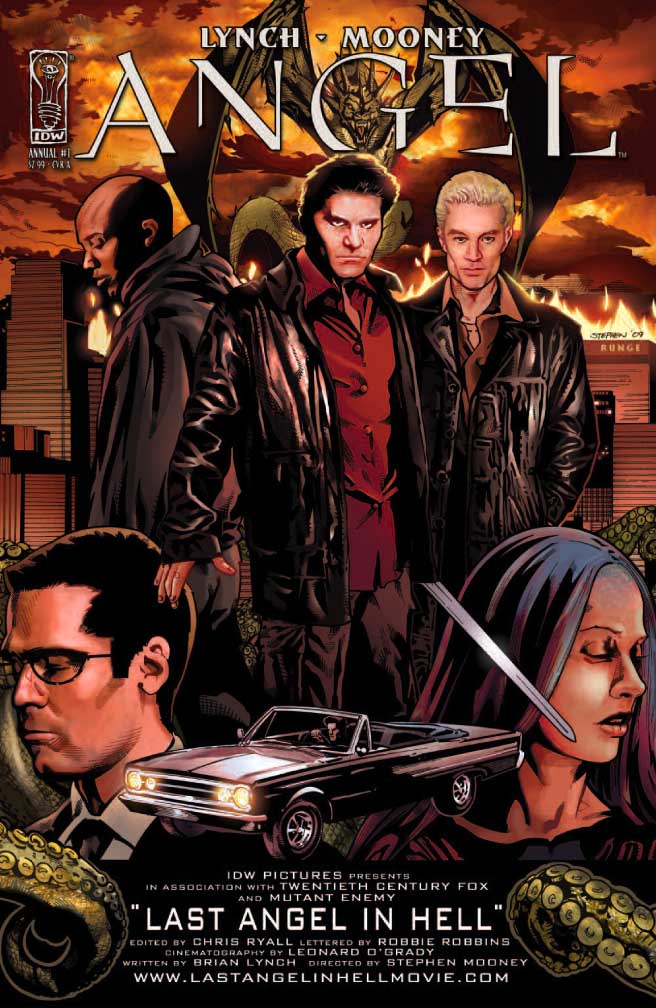A Chat with “Half Past Danger’s” Stephen Mooney

Every once in a while, a comic classic comes along, bursting forth fully formed out of the ether. It stands there on its formidable legs and whacks you across the face with its awesomeness. This past year, the book Half Past Danger (published by the fine folks at IDW), the brainchild of writer/artist Stephen Mooney, was the one that did that for me.
I’m not sure where I heard about it first. It could have been through my local shop Escape Pod Comics or maybe a post on the internet. Either way, the old fashioned flavoring of action & adventure really hit the sweet spot for me. I had to know more about the guy who was responsible for so much awesomeness. So without further adieu, here is my long awaited chat with Stephen Mooney!
Matt: So walk us through your artistic journey. When did you know that art was something you had an aptitude for?
Stephen: I suppose it was like a lot of others, in school at a young age. I used to devour all of the Tintin and Asterix books once I started reading at a decent basic level, and soon after that I began copying the figures from those and other children’s comics.
Matt: Did you have any formal training?
Stephen: Yep, I have a degree in classical animation which I studied here in Dublin from the year 1997 until 2001. I knew I wanted to draw comics before I went to college, but there was no dedicated sequential art course here in Ireland at the time, and to my knowledge there still isn’t. So I figured animation would be the next best thing, since it concentrated on many of the same disciplines, like life drawing, location drawing and storytelling. We drew solidly for forty hours a week, which suited me down to the ground.
Besides that, I took various art courses in the evenings during my school years.
Matt: Freak Show is one of your earlier credits. What did you learn while working on the book?
Stephen: I learned how to work from a script, how to keep a deadline, and how to ink. How to work as part of a comics team, how to format pages for print. How to letter. Many things. I was on that book for the guts of two years, and it provided me with a very solid grounding in the medium, as well as a fairly decent page rate for a first time professional comics job. I’d been working in animation for the two years leading up to that, and as soon as I managed to find a full time monthly comic gig I quit the day job. I still freelance now and again in animation, that said, and have many friends in the industry.
Matt: I’m a Brian Lynch fan, going back to his indie film and Angry Naked Pat days. What was it like working on IDW’s Angel with him?
Stephen: Man, it was a blast. Brian is just one of the warmest, wittiest and most personable fellows I’ve ever had the pleasure to have met and worked with. Bottom line though, he’s just a hell of a writer.
Those scripts were little examples of perfected episodic storytelling. I learned an awful lot about the craft of writing from Brian, almost through sheer osmosis. The Angel books were probably my favourite thing I’d ever gotten to work on up until I got to branch out on my own with Half Past Danger. Brian was incredibly gracious and collaborative, a joy to work with. I’d join him on another project in a heartbeat.
Matt: Licensed properties like Joss Whedon’s Angel come with their own set of challenges, I’m sure. Do you enjoy working on licensed properties? Is that something you’d like to do more of in the future as a writer/artist?
Stephen: I do enjoy working on properties that I grew up loving, like Angel or something like Star Trek. I’d certainly have an arc of something like GI Joe in me if I was given the opportunity in the future, and it’s something I’ve discussed with the editor at IDW, so we’ll see. Going forward right now though, I’m more excited about working on my own creations. That said, there’s an undeniable thrill at getting to add to the lexicon of one of your favourite properties!
Matt: I wonder if working on that type of property (Angel) had anything to do with the gleeful madness of Half Past Danger. Just in the regard of playing around with familiar archetypes. In reading Half Past Danger, I feel like we can almost see you dumping out a toy box and going to town with the characters that tumble out. Is that a fair assessment? Were you an action figure kid when you were growing up?
Stephen: That’s a very fair assessment! In fact you’re pretty bang on. It’s all of the elements and scenarios I loved as a kid watching movies on a Saturday afternoon in front of the TV in one huge melting pot. The challenge was making all of those disparate segments meld seamlessly into one grand narrative. Whether or not I managed that isn’t for me to judge, but I’m certainly satisfied with how the story is progressing.
Matt: Half Past Danger at first seems very familiar, and you’ve made no secret of the Indiana Jones influences. So let’s dig a bit deeper. What other wells are you drawing from? And what is the secret to mashing up various genres and characters so effortlessly?
Stephen: Oh man, so many different influences. Mostly from the pulp serials of the 30’s and 40’s, as well as the classic Spielberg action-adventure movies I loved as a kid. Westerns, war movies; it’s all in there. I guess Half Past Danger is the resulting distillation of all of those aspects of my childhood.
Matt: How long have you been developing this story?
Stephen: About two and a half years in total now. But the roots of the story stretch back almost as far as my childhood, when I first started leaning towards the notion of drawing a story that encompassed all of the genres I loved.
Matt: You colored the first issue beautifully, but I don’t think any artist would complain about the great Jordie Bellaire lending a hand. What brought on collaborating with Jordie? How is it working with her?
Stephen: Jordie came onboard when she saw me floundering! Jordie’s boyfriend, Dec Shalvey, is a good mate of mine here in Ireland, so I’ve known her quite a long time now. Certainly before she evolved into the colouring behemoth she is today! I had coloured the first issue of the book, but it was taking me far longer than I’d like, and I simply realized that if I continued at that glacial pace that the book would take forever to come out. Jordie saw the bind I was in and simply offered to lend me a hand. I’ll be eternally grateful to her that she did. Working with her was rocky at times, since we’re so bloody close and always bugged the hell out’ve each other! At the end of the day though, her work was brilliant, and raised the book several levels. I’d work with her on every book for the rest of my career if I could, genuinely.
Matt: Back to the nuts and bolts of storytelling, I’m curious about your thoughts on this: as someone who wears their Lucas-ian influence on their sleeve, do you subscribe to the Joseph Campbell theory of “the hero of a thousand faces”?
Stephen: To an extent I do, sure. There’s definitely a lot of truth and sense in the theories he offers. That said though, I think if you broke down the main beats of almost any of the myths and legends from every walk of life and every different populace, it’d be inevitable that common elements would present themselves from each version. I guess it’s just the human story, the tale of the hero triumphing over adversary. We all recall stories like that, even if we don’t necessarily remember where we first encountered them.
Matt: Speaking of heroes, who are some of your comic creating heroes? Who inspires you?
Stephen: My favourite artists are the more ‘classical’ school of guys; people like Mark Schultz, Dave Stevens, Adam Hughes, Barry Windsor-Smith and Alex Toth. More contemporary people that inspire me to draw are Stuart Immonen and Sean Murphy. but it’s always changing. The thing that inspires me to tell stories are usually great films. Movies are far and away my biggest influence. Comics are a distant second, but I’m always looking at the newest thing to see how the medium is progressing.
Matt: Tell us a little bit about the hardcover that is out!
Stephen: The hardcover came out a few weeks ago now, and it’s a beast. All 160 pages of the main story are in there, as well as fifty or so pages of backup material. IDW were very encouraging in allowing me add all of the supplemental stuff. They’ve been fantastic to work with in general, to be honest. I used to look at their gorgeous hardcover volumes and long for one of my own. The production values are simply some of the best in the industry, and there’s no expense spared in making the material sing. So yeah, I’m utterly delighted with how the first book turned out.
Matt: So what is next for Stephen Mooney? Is there a Half Past Danger 2 in the works?
Stephen: Up next is a Wolverine hardcover that I illustrated for Marvel. That was an absolute blast to work on, with many of the characters that I adored as a teen. It’s an unusual format, in that it mixes sequential art with illustrated prose, and it’s a 64 page digest sized book. I’m not sure as yet exactly when it arrives in stores.
After that I can’t say as yet, though I’m pretty sure what it will be. I’m currently writing the second volume of Half Past Danger (of three), and the first issue of that will most likely arrive early 2015. Exciting times!
Matt: Thank you so much for your time, Stephen! I hope we can chat again soon.
In addition to interviewing creators and reviewing comics, Matt likes to write comics of his own, including prose short stories and novels. He is based in New York, where he lives with his beautiful wife and newborn son.
Article/interview is © 2014 Matt Kelly. All rights reserved.
_________________________________________________________
Half Past Danger is TM and © 2014 Stephen Mooney. All rights reserved.
Tintin is TM and © 2014 HERGÉ / Moulinsart. All rights reserved.
Asterix is TM and © 2014 Albert René. All rights reserved.
Freak Show is TM and © 2014 Robert Curley. All rights reserved.
Angry Naked Pat is TM and © 2014 Brian Lynch. All rights reserved.
Angel is TM and © 2014 20th Century Fox. All rights reserved.
Star Trek is TM and © 2014 Paramount Pictures. All rights reserved.
GI Joe is TM and © 2014 Hasbro, Inc. All rights reserved.
Indiana Jones is TM and © 2014 Lucasfilm, LTD / Disney. All rights reserved.
Wolverine is TM and © 2014 Marvel Comics / Disney. All rights reserved.






Leave a Reply